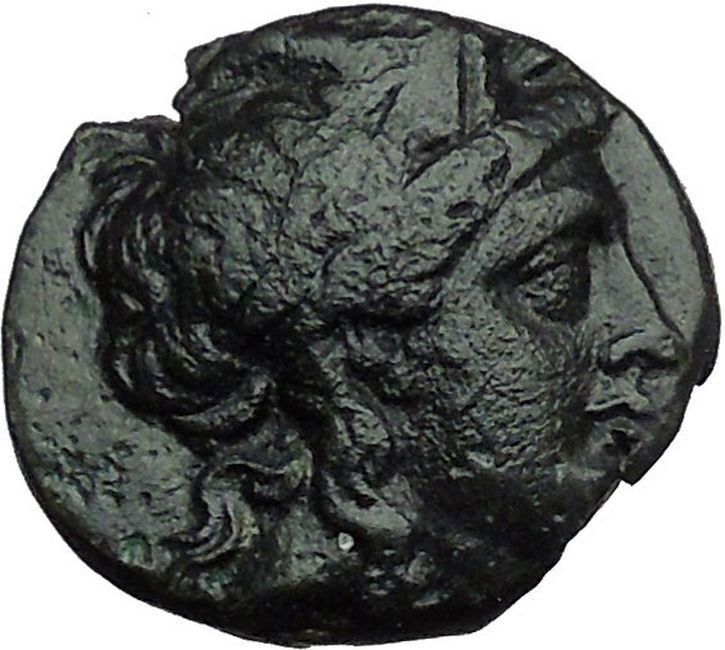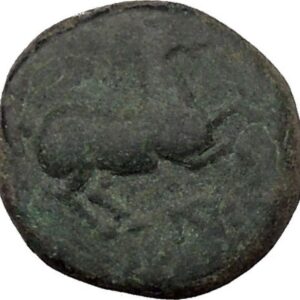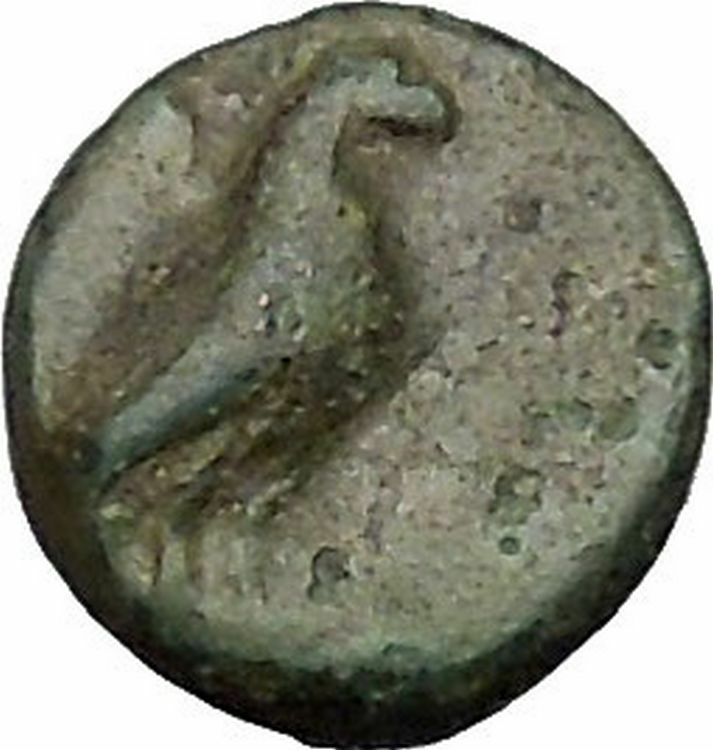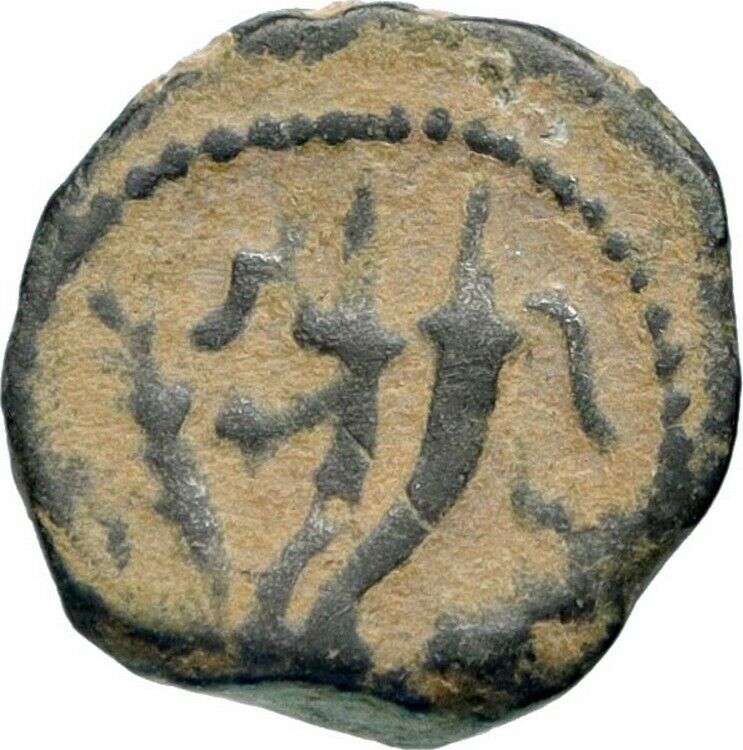|
Greek City of Magnesia (ad Maeandrum) in Ionia
Bronze 14mm (1.77 grams) Struck circa 400-350 B.C.
Reference: SNG München 593; SNG Copenhagen 802; SNG Kayhan 408
Laureate head of Apollo left.
Forepart of bull butting right, MAΓ above.
Situated south-east of Ephesus, on a tributary of the Maeander,
Magnesia was originally founded from Thessaly but was re-established by
colonists from Miletos in the 7th century B.C.
You are bidding on the exact item pictured,
provided with a Certificate of Authenticity and Lifetime Guarantee of
Authenticity.

In
Greek
and
Roman mythology
, Apollo
,
is one of the most important and diverse of the
Olympian deities
. The ideal of the
kouros
(a
beardless youth), Apollo has been variously recognized as a god of light and the
sun; truth and prophecy;
archery
;
medicine and healing; music, poetry, and the arts; and more. Apollo is the son
of Zeus
and
Leto, and has a
twin
sister, the chaste huntress
Artemis
.
Apollo is known in Greek-influenced
Etruscan mythology
as Apulu. Apollo was worshiped in both
ancient Greek
and
Roman religion
, as well as in the modern
Greco
–Roman
Neopaganism
.
As the patron of Delphi
(Pythian Apollo), Apollo was an
oracular
god — the prophetic deity of the
Delphic Oracle
.
Medicine and healing were associated with Apollo, whether through the god
himself or mediated through his son
Asclepius
,
yet Apollo was also seen as a god who could bring ill-health and deadly
plague
as well as one who had the ability to cure. Amongst the god’s
custodial charges, Apollo became associated with dominion over
colonists
, and as the patron defender of herds and flocks. As the leader of
the Muses
(Apollon
Musagetes) and director of their choir, Apollo functioned as the patron god
of music and poetry
.
Hermes
created
the lyre
for him,
and the instrument became a common
attribute
of Apollo. Hymns sung to Apollo were called
paeans
.
In Hellenistic times, especially during the third century BCE, as Apollo
Helios he became identified among Greeks with
Helios
,
god of
the sun
, and his sister Artemis similarly equated with
Selene
,
goddess
of the moon
.
In Latin texts, on the other hand, Joseph Fontenrose declared himself unable to
find any conflation of Apollo with
Sol
among the
Augustan poets
of the first century, not even in the conjurations of
Aeneas
and
Latinus
in
Aeneid
XII
(161–215).
Apollo and Helios/Sol remained separate beings in literary and mythological
texts until the third century CE.
Magnesia
(Greek:
Μαγνησία, MagnisÃa, IPA: [maÉ£niˈsia]),
deriving from the tribe name
Magnetes
,
is the name of the southeastern area of
Thessaly
in
central Greece
.
The modern prefecture (�ομός Μαγνησίας) was created in 1947 out of the Larissa
prefecture. About 70% of the population live in the Greater
Volos
area which
is the second-largest city in Thessaly and the third busiest commercial port in
Greece. Much of the population lives near the
Pagasetic Gulf
and in the eastern part. The chemical element,
Magnesium
,
was named after the “City of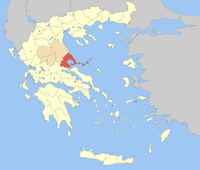 Magnesia” by Sir Humphrey Davy in 1808[citation Magnesia” by Sir Humphrey Davy in 1808[citation
needed]
The capital of Magnesia prefecture is the metropolitan city of
Volos
. According
to the most recent census (2001), the population stands at 207,000. The
prefecture of Magnesia includes the
Northern
Sporades
group of islands (Skiathos,
Skopelos
and Alonissos
.
The prefecture also includes the
Alonissos Marine Park
. The prefecture hosts 2,000,000 tourists annually.
Magnesia is represented in the
Greek Parliament
by five members.
//
Geography
The natural landscape of Magnesia consists of wooded mountains, cultivated
flat land, and coastline. One of the area’s main elements is the
Pelion
mountain
range which is located the eastern region of the Prefecture and forms the
eastern edge of the
Pagasetic Gulf
.
The ranges’ highest peak is
Pourianos Stavros
or Xeforti, (altitude 1624 metres). On the edge of
Magnesia
peninsula
Tiseo
mountain is found, which is considered to be the Southeast edge of
Pelion
.
Mt.
Maurovouni
(1054 metres) is the northeastly most mountain of the prefecture
and extends to the neighboring prefecture of
Larissa
.
The southwest border of the prefecture is Mt.Othry,
with its highest peak called
Gerakovouni
(1726 metres) and forms the boundary with the prefecture of
Phthiotis
.
The interior of Magnesia has two plains. One found between Mt. Halkodonio
(725 metres) and Othry is called
Almyros
plain
, while the
other between Halkodonio and
Pelion
is
called the Volos
–Velestino
plain. The hydrological network of the prefecture is not particularly rich and
is characterized by the absence of big
rivers
. The waters coming from
Pelion
shape
the rivers Anavros
, Platanorema, and Xirias.
In the North
section of the prefecture
Lake Karla
was formerly found. Lake Karla was drained in 1962, but attempts have been made
for its partial restoration.
On the bight of Sourpi
, next to
Amaliapolis
a coastal
wetland
is
found, with various species of
migratory birds
. This wetland together with the forest of
Kouri
– an
infrequent lowland
of Oak
tree forest
close to Almyros
– is included in the list of the protected regions of the
European
Network Natura 2000
.
The
Pagasetic Gulf
dominates the interior coastline of Magnesia.
Climate
The average
temperature
is 17
degrees Celsius
and the average rainfall about 540 millimetres per year.
Heat waves and intense cold periods are rare. During the summer the temperature
rises up to about 37 to 38 °C in August. The climate varies in different parts
of the prefecture; close to the
Pagasetic Gulf
conditions are humid, in
Nea Ionia
it is quite dry and in
Velestino
and Almyros
is the climate is continental. In winter there is significant
snowfall in the mountains and often freezing temperatures.
History
Antiquity
According to Hesiod
‘s (probably) “Eoiae” (Greek:
Ηοίαι) or “Catalogue
of Women“[2]
on the origin of the
Greeks
, Pandora
(named after her grandmother
Pandora
,
sister of Hellen
and daughter of
Deukalion
and Pyrrha
) together with Zeus had one son
Graecus
,
while Zeus had two more with
Thyia
, another of
Deukalion’s daughter:
Magnes
and
Macedon
. Magnes and Makednos together with
Hellen
‘s three
sons Dorus
,
Xuthus
(with
his sons
Ion
and
Achaeus
) and
Aeolos
, comprised the set of progenitors of the ancient tribes that formed
the Greek
/Hellenic
nation. Magnes ruled the area and people under his name. Magnesia is also
homeland of the mythical heroes
Jason
,
Peleus
and his
son Achilles
.
The word magnet
comes from the Greek “magnÃtis lÃthos” (μαγνήτης λίθος), which means “magnesian
stone”. The names for the elements
magnesium
and manganese
are also derived from this region, which in addition to the magnetic magnetite
(an iron ore), produces certain ores of magnesium and manganese that were known
to alchemists. The Magnetes contributed to the
Greek colonization
, with their main colonies being established before the
7th century BC, under the names of Magnesia beside Sipylus in Lydia and Magnesia
on the Maeander in Ionia.
Christian
era
Written accounts and remains from the 5th century AD document the appearance
of Christianity in Magnesia. The minutes of the 3rd Ecumenical Conference are
co-signed by the Bishop of Dimitriada Cleonikos. Five basilicas have been
revealed in Nea Anhialos, showing that the area was undergoing a spiritual
growth in that era. Magnesias has churches, monasteries and chapels, many of
which are architectural masterpieces in the style that is called “Pelioritica”.
In the area of Pelion are the monastery of Saint Yerasimos in Makrinitsa, The
Holy Archangels in Agios Georgios Nilias, Osios Lavredios in Agios Lavrendis,
Saint John the Baptist in Siki and Saint Spiridon in Promiri. The most famous is
the Monastery in Flamouri, built in the 16th century by Osios Simeon, the
so-called “barefoot and loin-clothed”, located above Veneto.
In the Almiros area and on the mountain of Othris two other monasteries were
built, one inhabited by
monks
in Ano Pagania (Virgin Mary) Xenia and the other by
nuns
in Kato Panagia Xenia. This monastery holds historical monuments of the
area from the 12th century, with of frescoes, treasuries and a library. In Kato
Panagia Xenia monastery, an icon of the Virgin Mary, venerated by the people of
the area, is kept. All the monasteries are of archeological, historical and
artistic interest and are accessible (the one in Flamouri only by men).
|






 Magnesia” by Sir Humphrey Davy in 1808[citation
Magnesia” by Sir Humphrey Davy in 1808[citation 